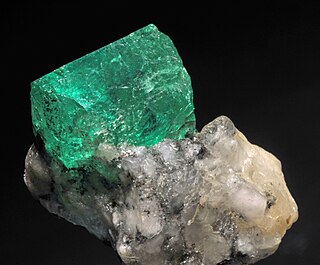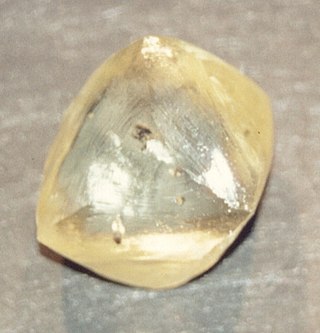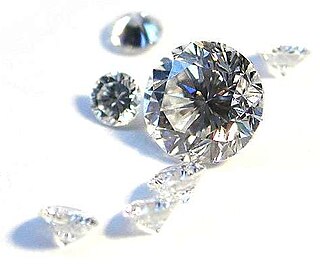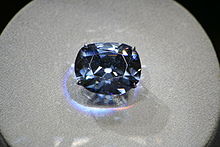
Diamond is a solid form of the element carbon with its atoms arranged in a crystal structure called diamond cubic. Another solid form of carbon known as graphite is the chemically stable form of carbon at room temperature and pressure, but diamond is metastable and converts to it at a negligible rate under those conditions. Diamond has the highest hardness and thermal conductivity of any natural material, properties that are used in major industrial applications such as cutting and polishing tools. They are also the reason that diamond anvil cells can subject materials to pressures found deep in the Earth.

Emerald is a gemstone and a variety of the mineral beryl (Be3Al2(SiO3)6) colored green by trace amounts of chromium or sometimes vanadium. Beryl has a hardness of 7.5–8 on the Mohs scale. Most emeralds have much material trapped inside during the gem's formation, so their toughness (resistance to breakage) is classified as generally poor. Emerald is a cyclosilicate.

A gemstone is a piece of mineral crystal which, when cut or polished, is used to make jewelry or other adornments. Certain rocks and occasionally organic materials that are not minerals may also be used for jewelry and are therefore often considered to be gemstones as well. Most gemstones are hard, but some softer minerals such as brazilianite may be used in jewelry because of their color or luster or other physical properties that have aesthetic value. However, generally speaking, soft minerals are not typically used as gemstones by virtue of their brittleness and lack of durability.

Sapphire is a precious gemstone, a variety of the mineral corundum, consisting of aluminium oxide (α-Al2O3) with trace amounts of elements such as iron, titanium, cobalt, lead, chromium, vanadium, magnesium, boron, and silicon. The name sapphire is derived from the Latin word sapphirus, itself from the Greek word sappheiros (σάπφειρος), which referred to lapis lazuli. It is typically blue, but natural "fancy" sapphires also occur in yellow, purple, orange, and green colors; "parti sapphires" show two or more colors. Red corundum stones also occur, but are called rubies rather than sapphires. Pink-colored corundum may be classified either as ruby or sapphire depending on locale. Commonly, natural sapphires are cut and polished into gemstones and worn in jewelry. They also may be created synthetically in laboratories for industrial or decorative purposes in large crystal boules. Because of the remarkable hardness of sapphires – 9 on the Mohs scale (the third hardest mineral, after diamond at 10 and moissanite at 9.5) – sapphires are also used in some non-ornamental applications, such as infrared optical components, high-durability windows, wristwatch crystals and movement bearings, and very thin electronic wafers, which are used as the insulating substrates of special-purpose solid-state electronics such as integrated circuits and GaN-based blue LEDs. Sapphire is the birthstone for September and the gem of the 45th anniversary. A sapphire jubilee occurs after 65 years.

A ruby is a pinkish red to blood-red colored gemstone, a variety of the mineral corundum. Ruby is one of the most popular traditional jewelry gems and is very durable. Other varieties of gem-quality corundum are called sapphires. Ruby is one of the traditional cardinal gems, alongside amethyst, sapphire, emerald, and diamond. The word ruby comes from ruber, Latin for red. The color of a ruby is due to the element chromium.

Tanzanite is the blue and violet variety of the mineral zoisite, caused by small amounts of vanadium. Tanzanite belongs to the epidote mineral group. Tanzanite is only found in Simanjiro District of Manyara Region in Tanzania, in a very small mining area approximately 7 km (4.3 mi) long and 2 km (1.2 mi) wide near the Mererani Hills.

The Argyle Diamond Mine was a diamond mine located in the East Kimberley region in the remote north of Western Australia. Argyle was at times the largest diamond producer in the world by volume, although the proportion of gem-quality diamonds was low. It was the only known significant source of pink and red diamonds, and additionally provided a large proportion of other naturally coloured diamonds, including champagne, cognac and rare blue diamonds.
Gemesis Inc. was a privately held company located in New York City. The company grew synthetic diamonds using proprietary technology.

A chemically pure and structurally perfect diamond is perfectly transparent with no hue, or color. However, in reality almost no gem-sized natural diamonds are absolutely perfect. The color of a diamond may be affected by chemical impurities and/or structural defects in the crystal lattice. Depending on the hue and intensity of a diamond's coloration, a diamond's color can either detract from or enhance its value. For example, most white diamonds are discounted in price when more yellow hue is detectable, while intense pink diamonds or blue diamonds can be dramatically more valuable. Of all colored diamonds, red diamonds are the rarest. The Aurora Pyramid of Hope displays a spectacular array of naturally colored diamonds, including red diamonds.
Diamond enhancements are specific treatments, performed on natural diamonds, which are designed to improve the visual gemological characteristics of the diamond in one or more ways. These include clarity treatments such as laser drilling to remove black carbon inclusions, fracture filling to make small internal cracks less visible, color irradiation and annealing treatments to make yellow and brown diamonds a vibrant fancy color such as vivid yellow, blue, or pink.

A diamond simulant, diamond imitation or imitation diamond is an object or material with gemological characteristics similar to those of a diamond. Simulants are distinct from synthetic diamonds, which are actual diamonds exhibiting the same material properties as natural diamonds. Enhanced diamonds are also excluded from this definition. A diamond simulant may be artificial, natural, or in some cases a combination thereof. While their material properties depart markedly from those of diamond, simulants have certain desired characteristics—such as dispersion and hardness—which lend themselves to imitation. Trained gemologists with appropriate equipment are able to distinguish natural and synthetic diamonds from all diamond simulants, primarily by visual inspection.

The Gemological Institute of America (GIA) is a nonprofit institute based in Carlsbad, California. It is dedicated to research and education in the field of gemology and the jewelry arts. Founded in 1931, GIA's mission is to protect buyers and sellers of gemstones by setting and maintaining the standards used to evaluate gemstone quality. The institute does so through research, gem identification, diamond grading services, and a variety of educational programs. Through its library and subject experts, GIA acts as a resource of gem and jewelry information for the trade, the public and media outlets.

Diamonds were largely inaccessible to investors until the recent advent of regulated commodities, due to a lack of price discovery and transparency. The characteristics of individual diamonds, especially the carat weight, color and clarity, have significant impact on values, but transactions were always private. With the standardized commodity as an underlying asset, several market traded financial instruments have been announced.

Diamond is a gemstone formed by cutting a raw diamond. Diamonds are one of the best-known and most sought-after gems, and they have been used as decorative items since ancient times.
WD Lab Grown Diamonds ("WD") was a market leader in Chemical Vapor Deposition (CVD) diamonds, headquartered in the Washington, D.C. area. Founded in 2008, WD produces lab-grown diamonds for distribution under the brands, in addition to creating diamonds for high-tech Advanced Materials applications.
The Archduke Joseph is a colorless, antique cushion-shaped brilliant, originally weighing 78.54 carat, purchased by Molina Jewelers of Arizona sometime in the late-1990s and slightly re-cut to 76.45 carat to improve clarity and symmetry. It is, on the Gemological Institute of America (GIA) color and clarity scales, a D grade, IF diamond and the largest DIF ever graded at the GIA; and it is of type IIa.

The Ocean Paradise is a diamond measuring 1.6 carats after polish and was discovered in Brazil and currently owned by the Nahshonov Group. When discovered, it measured 6.43 carats. The Ocean Paradise is the second and one of the only natural diamonds known to the GIA to possess a blue-green hue, making it one of the rarest diamonds in the world.
The Winston Blue is the name given to what was the largest flawless vivid blue diamond bought by Harry Winston, Inc. on May 15, 2014, from an anonymous person for $23.8 million at Christie's Geneva Magnificent Jewels sale. The approximately $1.8003 million per carat price paid for the 13.22-carat diamond is a world record for a blue diamond. Harry Winston, Inc. had also bought a 101.73-carat colorless diamond named Winston Legacy at Christie's Geneva jewelry auction in 2013. The American luxury jeweler had then paid $26.7 million for the colorless diamond, which is a world record for the highest price paid per carat for a colorless diamond.

Pink diamond is a type of diamond that has pink color. The source of their pink color is greatly debated in the gemological world but it is most commonly attributed to plastic deformation that these diamonds undergo during their formation.

A red diamond is a diamond which displays red color and exhibits the same mineral properties as colorless diamonds. Red diamonds are commonly known as the most expensive and the rarest diamond color in the world, even more so than pink or blue diamonds, as very few red diamonds have been found. Red diamonds, just like pink diamonds, are greatly debated as to the source of their color, but the gemological community most commonly attributes both colors to gliding atoms in the diamond's structure as it undergoes enormous pressure during its formation. Red diamonds are among the 12 colors of fancy color diamonds, and have the most expensive price per carat. They will typically run in the hundreds of thousands of dollars per carat range. Since they are the rarest color, it is difficult to find them in large sizes, and they are mostly found in sizes less than 1 carat. Red diamonds only exist with one color intensity, Fancy, although their clarities can range from Flawless to Included, just like white diamonds. The largest and most flawless red diamond is the 5.11 carat Fancy Red Moussaieff Red Diamond, which has internally flawless clarity.


















